instrument panel Alfa Romeo 4C Spider 2016 Owner's Manual
[x] Cancel search | Manufacturer: ALFA ROMEO, Model Year: 2016, Model line: 4C Spider, Model: Alfa Romeo 4C Spider 2016Pages: 371, PDF Size: 2.93 MB
Page 3 of 371

TABLE OF CONTENTSSECTIONPAGE
1INTRODUCTION .
..............................................................3
2THINGS TO KNOW BEFORE STARTING YOUR VEHICLE
..................................9
3UNDERSTANDING THE FEATURES OF YOUR VEHICLE
..................................73
4UNDERSTANDING YOUR INSTRUMENT PANEL
.......................................117
5STARTINGANDOPERATING ....................................................173
6WHATTODOINEMERGENCIES..................................................245
7MAINTAININGYOURVEHICLE...................................................263
8MAINTENANCE SCHEDULES
....................................................329
9IF YOU NEED CONSUMER ASSISTANCE
............................................343
10INDEX .....................................................................353
1
2
3
4
5
6
7
8
9
10
Page 9 of 371
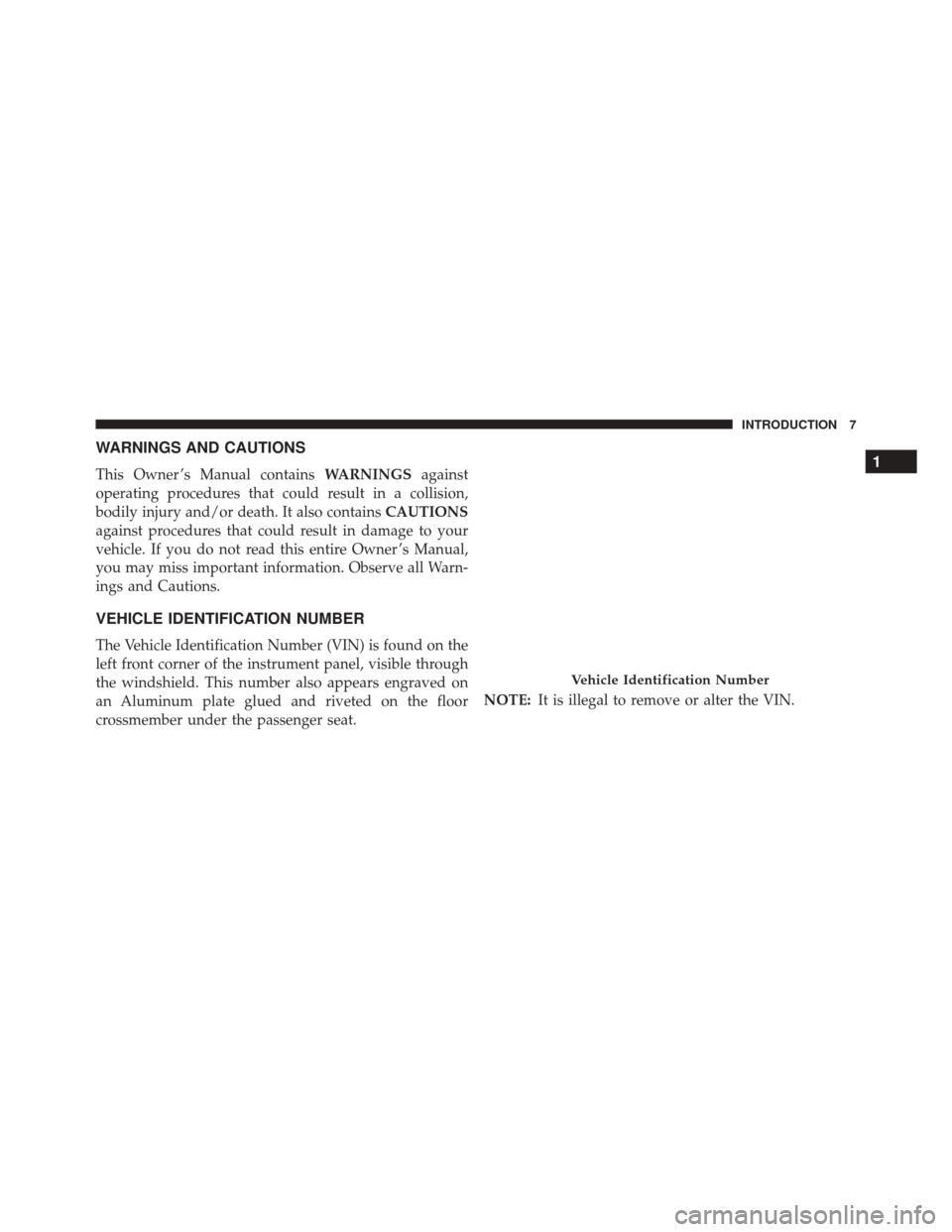
WARNINGS AND CAUTIONS
This Owner ’s Manual containsWARNINGSagainst
operating procedures that could result in a collision,
bodily injury and/or death. It also contains CAUTIONS
against procedures that could result in damage to your
vehicle. If you do not read this entire Owner ’s Manual,
you may miss important information. Observe all Warn-
ings and Cautions.
VEHICLE IDENTIFICATION NUMBER
The Vehicle Identification Number (VIN) is found on the
left front corner of the instrument panel, visible through
the windshield. This number also appears engraved on
an Aluminum plate glued and riveted on the floor
crossmember under the passenger seat. NOTE:
It is illegal to remove or alter the VIN.
Vehicle Identification Number
1
INTRODUCTION 7
Page 18 of 371
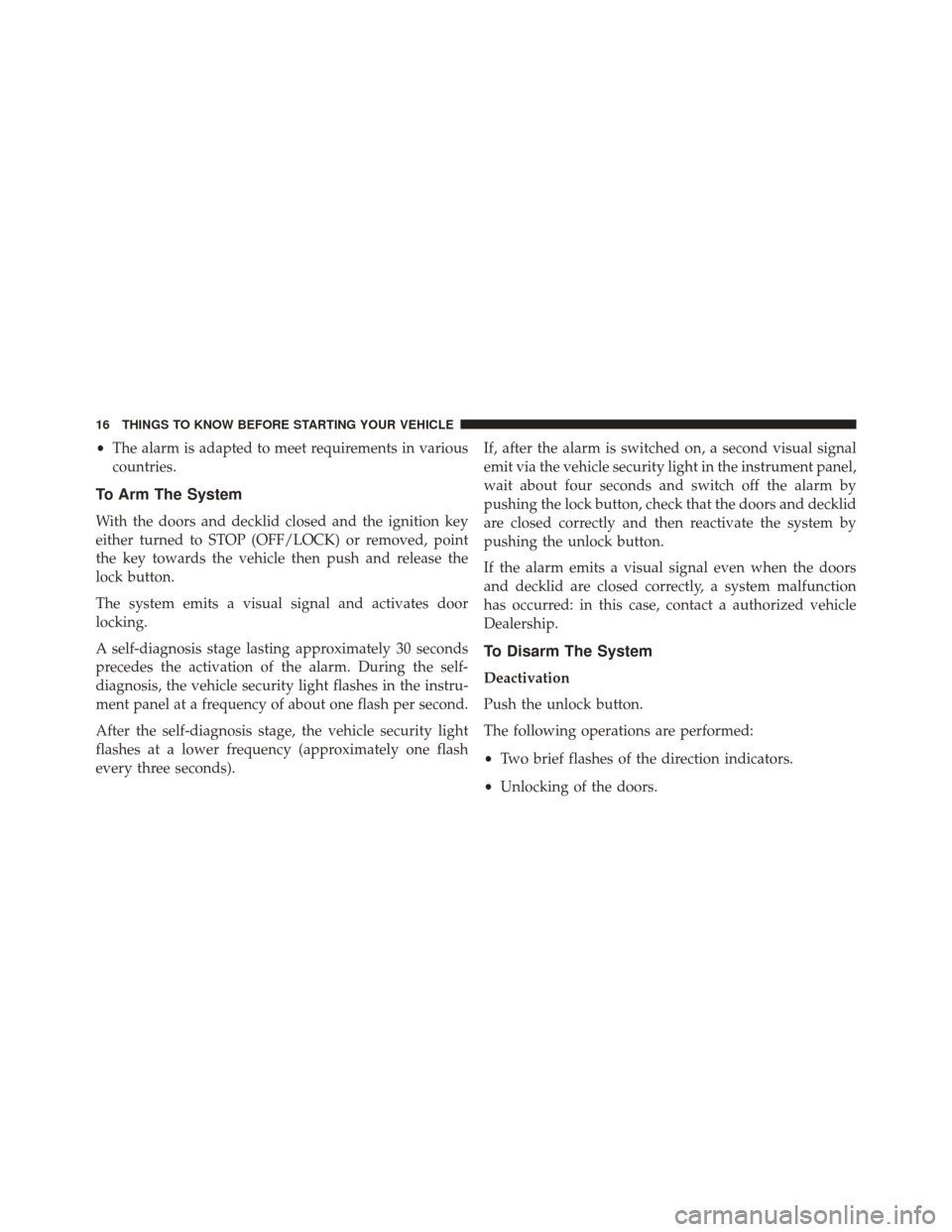
•The alarm is adapted to meet requirements in various
countries.
To Arm The System
With the doors and decklid closed and the ignition key
either turned to STOP (OFF/LOCK) or removed, point
the key towards the vehicle then push and release the
lock button.
The system emits a visual signal and activates door
locking.
A self-diagnosis stage lasting approximately 30 seconds
precedes the activation of the alarm. During the self-
diagnosis, the vehicle security light flashes in the instru-
ment panel at a frequency of about one flash per second.
After the self-diagnosis stage, the vehicle security light
flashes at a lower frequency (approximately one flash
every three seconds). If, after the alarm is switched on, a second visual signal
emit via the vehicle security light in the instrument panel,
wait about four seconds and switch off the alarm by
pushing the lock button, check that the doors and decklid
are closed correctly and then reactivate the system by
pushing the unlock button.
If the alarm emits a visual signal even when the doors
and decklid are closed correctly, a system malfunction
has occurred: in this case, contact a authorized vehicle
Dealership.
To Disarm The System
Deactivation
Push the unlock button.
The following operations are performed:
•
Two brief flashes of the direction indicators.
• Unlocking of the doors.
16 THINGS TO KNOW BEFORE STARTING YOUR VEHICLE
Page 21 of 371
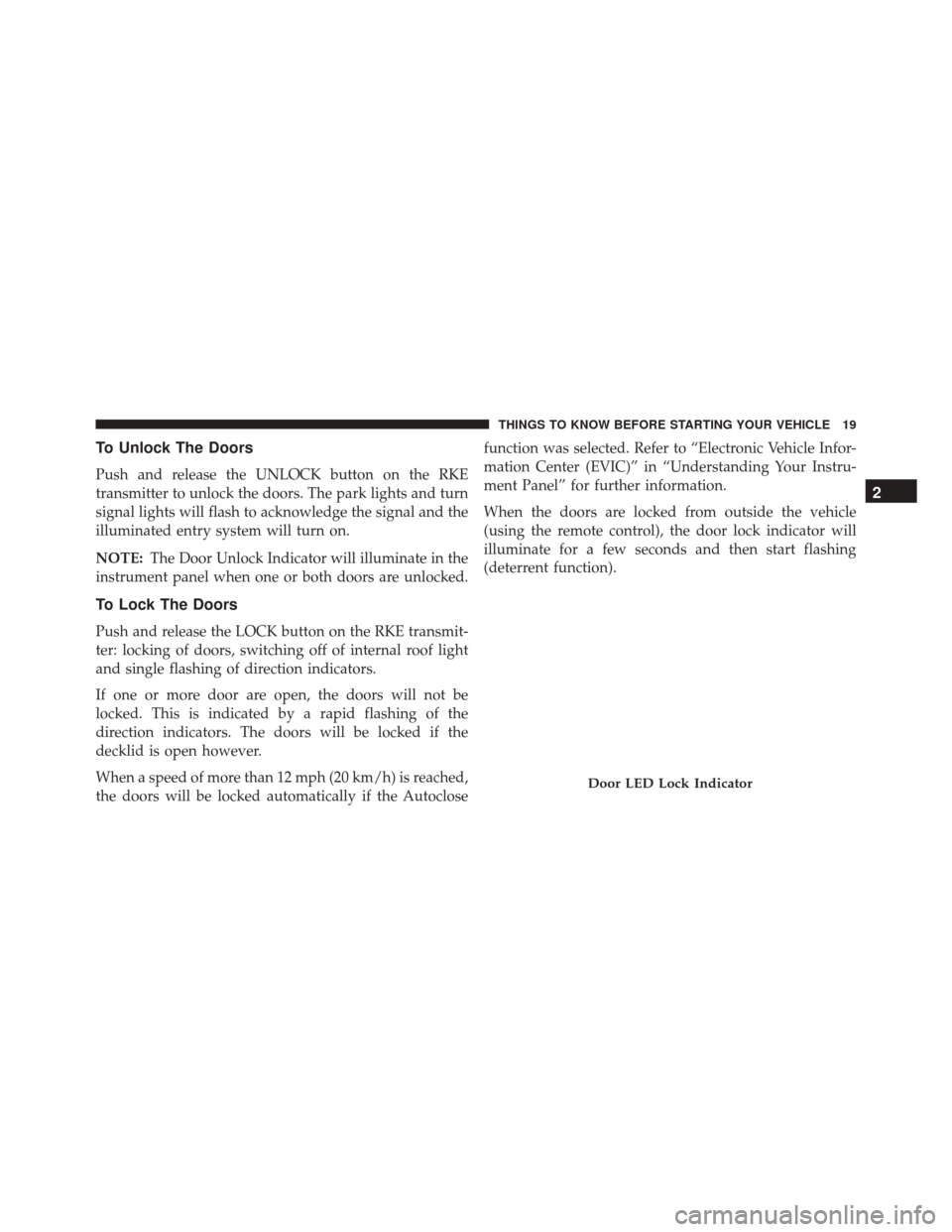
To Unlock The Doors
Push and release the UNLOCK button on the RKE
transmitter to unlock the doors. The park lights and turn
signal lights will flash to acknowledge the signal and the
illuminated entry system will turn on.
NOTE:The Door Unlock Indicator will illuminate in the
instrument panel when one or both doors are unlocked.
To Lock The Doors
Push and release the LOCK button on the RKE transmit-
ter: locking of doors, switching off of internal roof light
and single flashing of direction indicators.
If one or more door are open, the doors will not be
locked. This is indicated by a rapid flashing of the
direction indicators. The doors will be locked if the
decklid is open however.
When a speed of more than 12 mph (20 km/h) is reached,
the doors will be locked automatically if the Autoclose function was selected. Refer to “Electronic Vehicle Infor-
mation Center (EVIC)” in “Understanding Your Instru-
ment Panel” for further information.
When the doors are locked from outside the vehicle
(using the remote control), the door lock indicator will
illuminate for a few seconds and then start flashing
(deterrent function).
Door LED Lock Indicator
2
THINGS TO KNOW BEFORE STARTING YOUR VEHICLE 19
Page 44 of 371

How To Disengage The Automatic Locking Mode
Unbuckle the combination lap/shoulder belt and allow it
to retract completely to disengage the Automatic Locking
Mode and activate the vehicle sensitive (emergency)
locking mode.
WARNING!
•The seat belt assembly must be replaced if the
switchable Automatic Locking Retractor (ALR) fea-
ture or any other seat belt function is not working
properly when checked according to the proce-
dures in the Service Manual.
• Failure to replace the seat belt assembly could
increase the risk of injury in collisions.
• Do not use the Automatic Locking Mode to restrain
occupants who are wearing the seat belt or children
who are using booster seats. The locked mode is
(Continued)
WARNING! (Continued)
only used to install rear-facing or forward-facing
child restraints that have a harness for restraining
the child.
Supplemental Restraint System (SRS)
Air Bag System Components
Your vehicle may be equipped with the following air bag
system components:
•Occupant Restraint Controller (ORC)
• Air Bag Warning Light
•Steering Wheel and Column
• Instrument Panel
• Knee Impact Bolsters
• Advanced Front Air Bags
42 THINGS TO KNOW BEFORE STARTING YOUR VEHICLE
Page 45 of 371

•Supplemental Side Air Bags
• Supplemental Knee Air Bags
• Front and Side Impact Sensors
• Seat Belt Pretensioners
• Seat Belt Buckle Switch
• Seat Track Position Sensors
Advanced Front Air Bags
This vehicle has Advanced Front Air Bags for both the
driver and front passenger as a supplement to the seat
belt restraint systems. The driver ’s Advanced Front Air
Bag is mounted in the center of the steering wheel. The
passenger ’s Advanced Front Air Bag is mounted in the
instrument panel, above the glove compartment. The
words “SRS AIRBAG” or “AIRBAG” are embossed on
the air bag covers.
Advanced Front Air Bag Locations
1 — Driver And Passenger Advanced Front Air Bags
2 — Passenger Knee Bolsters
3 — Supplemental Driver Knee Air Bag/Driver Knee Bolster
2
THINGS TO KNOW BEFORE STARTING YOUR VEHICLE 43
Page 46 of 371
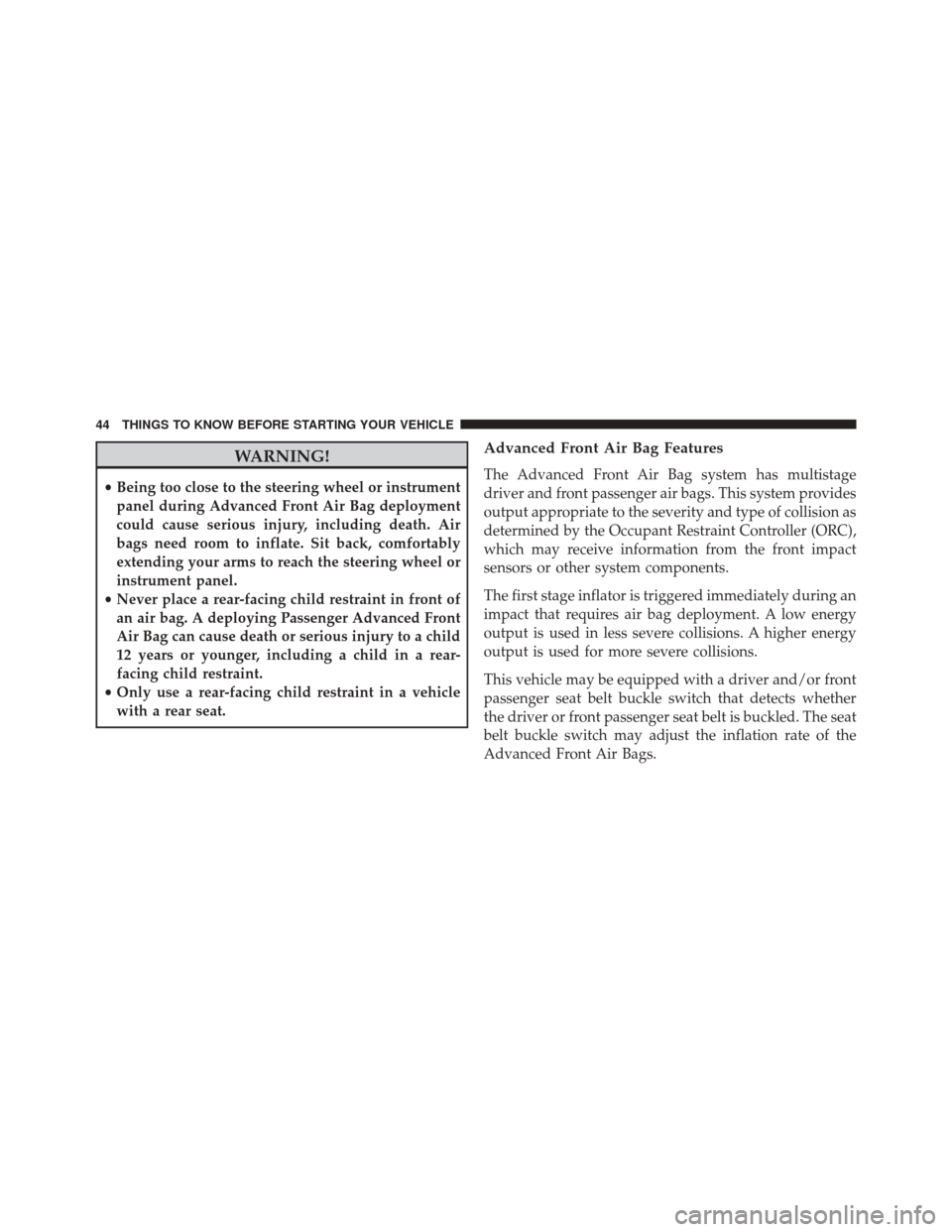
WARNING!
•Being too close to the steering wheel or instrument
panel during Advanced Front Air Bag deployment
could cause serious injury, including death. Air
bags need room to inflate. Sit back, comfortably
extending your arms to reach the steering wheel or
instrument panel.
• Never place a rear-facing child restraint in front of
an air bag. A deploying Passenger Advanced Front
Air Bag can cause death or serious injury to a child
12 years or younger, including a child in a rear-
facing child restraint.
• Only use a rear-facing child restraint in a vehicle
with a rear seat.
Advanced Front Air Bag Features
The Advanced Front Air Bag system has multistage
driver and front passenger air bags. This system provides
output appropriate to the severity and type of collision as
determined by the Occupant Restraint Controller (ORC),
which may receive information from the front impact
sensors or other system components.
The first stage inflator is triggered immediately during an
impact that requires air bag deployment. A low energy
output is used in less severe collisions. A higher energy
output is used for more severe collisions.
This vehicle may be equipped with a driver and/or front
passenger seat belt buckle switch that detects whether
the driver or front passenger seat belt is buckled. The seat
belt buckle switch may adjust the inflation rate of the
Advanced Front Air Bags.
44 THINGS TO KNOW BEFORE STARTING YOUR VEHICLE
Page 47 of 371

WARNING!
•No objects should be placed over or near the air
bag on the instrument panel or steering wheel
because any such objects could cause harm if the
vehicle is in a collision severe enough to cause the
air bag to inflate.
• Do not put anything on or around the air bag
covers or attempt to open them manually. You may
damage the air bags and you could be injured
because the air bags may no longer be functional.
The protective covers for the air bag cushions are
designed to open only when the air bags are
inflating.
• Relying on the air bags alone could lead to more
severe injuries in a collision. The air bags work
with your seat belt to restrain you properly. In
(Continued)
WARNING! (Continued)
some collisions, air bags won’t deploy at all. Al-
ways wear your seat belts even though you have air
bags.
Advanced Front Air Bag Operation
Advanced Front Air Bags are designed to provide addi-
tional protection by supplementing the seat belts. Ad-
vanced Front Air Bags are not expected to reduce the risk
of injury in rear, side, or rollover collisions. The Ad-
vanced Front Air Bags will not deploy in all frontal
collisions, including some that may produce substantial
vehicle damage — for example, some pole collisions,
truck underrides, and angle offset collisions.
On the other hand, depending on the type and location of
impact, Advanced Front Air Bags may deploy in crashes
with little vehicle front-end damage but that produce a
severe initial deceleration.
2
THINGS TO KNOW BEFORE STARTING YOUR VEHICLE 45
Page 48 of 371
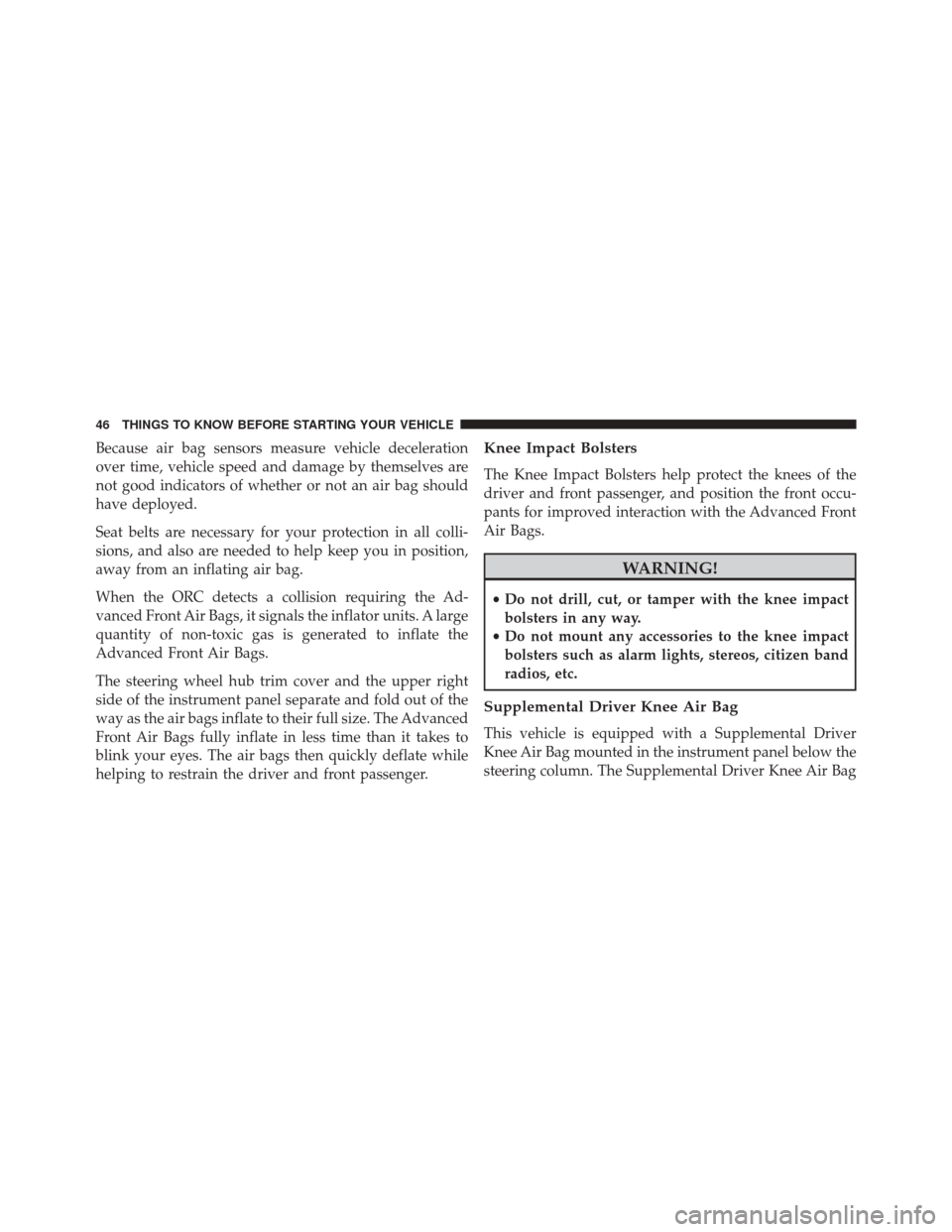
Because air bag sensors measure vehicle deceleration
over time, vehicle speed and damage by themselves are
not good indicators of whether or not an air bag should
have deployed.
Seat belts are necessary for your protection in all colli-
sions, and also are needed to help keep you in position,
away from an inflating air bag.
When the ORC detects a collision requiring the Ad-
vanced Front Air Bags, it signals the inflator units. A large
quantity of non-toxic gas is generated to inflate the
Advanced Front Air Bags.
The steering wheel hub trim cover and the upper right
side of the instrument panel separate and fold out of the
way as the air bags inflate to their full size. The Advanced
Front Air Bags fully inflate in less time than it takes to
blink your eyes. The air bags then quickly deflate while
helping to restrain the driver and front passenger.Knee Impact Bolsters
The Knee Impact Bolsters help protect the knees of the
driver and front passenger, and position the front occu-
pants for improved interaction with the Advanced Front
Air Bags.
WARNING!
•Do not drill, cut, or tamper with the knee impact
bolsters in any way.
• Do not mount any accessories to the knee impact
bolsters such as alarm lights, stereos, citizen band
radios, etc.
Supplemental Driver Knee Air Bag
This vehicle is equipped with a Supplemental Driver
Knee Air Bag mounted in the instrument panel below the
steering column. The Supplemental Driver Knee Air Bag
46 THINGS TO KNOW BEFORE STARTING YOUR VEHICLE
Page 53 of 371
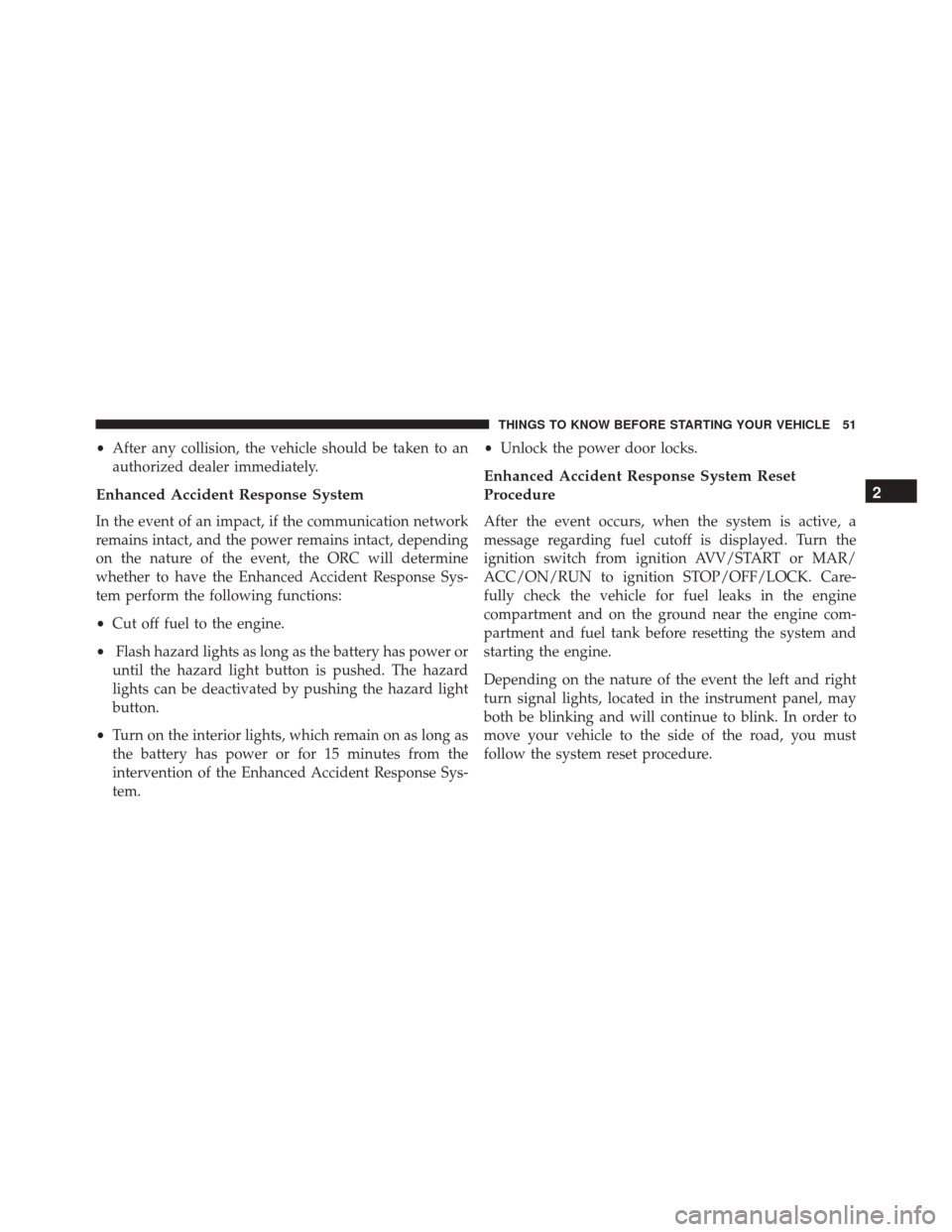
•After any collision, the vehicle should be taken to an
authorized dealer immediately.
Enhanced Accident Response System
In the event of an impact, if the communication network
remains intact, and the power remains intact, depending
on the nature of the event, the ORC will determine
whether to have the Enhanced Accident Response Sys-
tem perform the following functions:
• Cut off fuel to the engine.
• Flash hazard lights as long as the battery has power or
until the hazard light button is pushed. The hazard
lights can be deactivated by pushing the hazard light
button.
• Turn on the interior lights, which remain on as long as
the battery has power or for 15 minutes from the
intervention of the Enhanced Accident Response Sys-
tem. •
Unlock the power door locks.
Enhanced Accident Response System Reset
Procedure
After the event occurs, when the system is active, a
message regarding fuel cutoff is displayed. Turn the
ignition switch from ignition AVV/START or MAR/
ACC/ON/RUN to ignition STOP/OFF/LOCK. Care-
fully check the vehicle for fuel leaks in the engine
compartment and on the ground near the engine com-
partment and fuel tank before resetting the system and
starting the engine.
Depending on the nature of the event the left and right
turn signal lights, located in the instrument panel, may
both be blinking and will continue to blink. In order to
move your vehicle to the side of the road, you must
follow the system reset procedure.
2
THINGS TO KNOW BEFORE STARTING YOUR VEHICLE 51